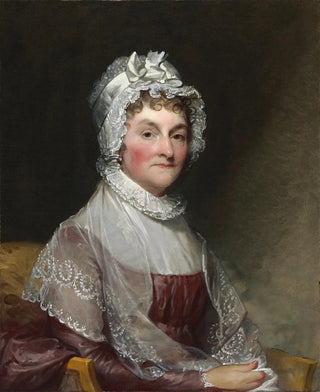Art print | Abigail Smith Adams Mme John Adams - Gilbert Stuart


View from behind

Frame (optional)
In the vast panorama of American art history, the "Art print Abigail Smith Adams Mme John Adams" by Gilbert Stuart stands out for its emotional depth and timeless elegance. Painted at the end of the 18th century, this iconic representation of the wife of the second U.S. president, John Adams, embodies not only classical beauty but also the crucial role of women in shaping American society. Stuart, master of the portrait, succeeds in capturing the very essence of his subject, offering viewers a glimpse into Abigail Adams' personality and values. Through this work, the artist invites us to explore the intimacy of a historical figure while revealing the nuances of a rapidly changing era.
Style and uniqueness of the work
Gilbert Stuart's style is characterized by striking realism and meticulous attention to detail. In "Art print Abigail Smith Adams Mme John Adams," the chiaroscuro technique is skillfully used to emphasize Abigail's facial features, giving her an aura of dignity and serenity. The luminosity emanating from her face contrasts with the dark background, highlighting her reflective expression and penetrating gaze. Every element of the composition, from the drapes of her dress to carefully chosen accessories, contributes to creating an atmosphere that is both intimate and majestic. The figure's posture, slightly inclined, evokes a certain closeness to the viewer, as if she is about to share her thoughts and convictions. This work is not limited to a simple physical representation; it transcends the traditional portrait to become a true statement on the role of women in history.
The artist and his influence
Gilbert Stuart, born in 1755, is often regarded as one of the greatest American portraitists. His prolific career, marked by prestigious commissions, allowed him to shape the image of several emblematic figures of his time, including George Washington. Stuart's influence extends well beyond his era, as his approach to portraiture paved the way for many subsequent artists. By emphasizing the psychology of his subjects, he was able to humanize his characters, endowing them with a dimension that still resonates today. His work on Abigail Adams demonstrates

Matte finish

View from behind

Frame (optional)
In the vast panorama of American art history, the "Art print Abigail Smith Adams Mme John Adams" by Gilbert Stuart stands out for its emotional depth and timeless elegance. Painted at the end of the 18th century, this iconic representation of the wife of the second U.S. president, John Adams, embodies not only classical beauty but also the crucial role of women in shaping American society. Stuart, master of the portrait, succeeds in capturing the very essence of his subject, offering viewers a glimpse into Abigail Adams' personality and values. Through this work, the artist invites us to explore the intimacy of a historical figure while revealing the nuances of a rapidly changing era.
Style and uniqueness of the work
Gilbert Stuart's style is characterized by striking realism and meticulous attention to detail. In "Art print Abigail Smith Adams Mme John Adams," the chiaroscuro technique is skillfully used to emphasize Abigail's facial features, giving her an aura of dignity and serenity. The luminosity emanating from her face contrasts with the dark background, highlighting her reflective expression and penetrating gaze. Every element of the composition, from the drapes of her dress to carefully chosen accessories, contributes to creating an atmosphere that is both intimate and majestic. The figure's posture, slightly inclined, evokes a certain closeness to the viewer, as if she is about to share her thoughts and convictions. This work is not limited to a simple physical representation; it transcends the traditional portrait to become a true statement on the role of women in history.
The artist and his influence
Gilbert Stuart, born in 1755, is often regarded as one of the greatest American portraitists. His prolific career, marked by prestigious commissions, allowed him to shape the image of several emblematic figures of his time, including George Washington. Stuart's influence extends well beyond his era, as his approach to portraiture paved the way for many subsequent artists. By emphasizing the psychology of his subjects, he was able to humanize his characters, endowing them with a dimension that still resonates today. His work on Abigail Adams demonstrates






